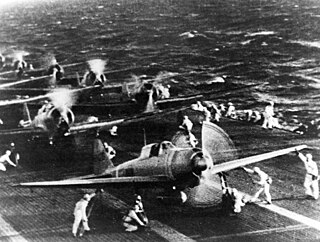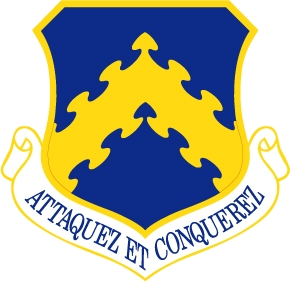Related Research Articles

The Guadalcanal campaign, also known as the Battle of Guadalcanal and codenamed Operation Watchtower by American forces, was a military campaign fought between 7 August 1942 and 9 February 1943 on and around the island of Guadalcanal in the Pacific theater of World War II. It was the first major land offensive by Allied forces against the Empire of Japan.

The Fifth Air Force is a numbered air force of the United States Air Force Pacific Air Forces (PACAF). It is headquartered at Yokota Air Base, Japan. It is the U.S. Air Force's oldest continuously serving Numbered Air Force. The organization has provided 70 years of continuous air power to the Pacific since its establishment in September 1941.

The Seventh Air Force is a Numbered Air Force of the United States Pacific Air Forces (PACAF). It is headquartered at Osan Air Base, South Korea.

The Thirteenth Air Force was a numbered air force of the United States Air Force Pacific Air Forces (PACAF). It was last headquartered at Hickam Air Force Base on the island of Oahu, Hawaii. 13 AF has never been stationed in the continental United States. It was one of the oldest continuously active numbered air forces in the United States Air Force.

The Asiatic–Pacific Campaign Medal is a United States military award of the Second World War, which was awarded to any member of the United States Armed Forces who served in the Asiatic-Pacific Theater from 1941 to 1945. The medal was created on November 6, 1942, by Executive Order 9265 issued by President Franklin D. Roosevelt. The medal was designed by Thomas Hudson Jones; the reverse side was designed by Adolph Alexander Weinman which is the same design as used on the reverse of the American Campaign Medal and European-African-Middle Eastern Campaign Medal.

The South-East Asian Theatre of World War II consisted of the campaigns of the Pacific War in Burma, India, Thailand, the Philippines, Indochina, Malaya and Singapore.

The Solomon Islands campaign was a major campaign of the Pacific War of World War II. The campaign began with Japanese landings and occupation of several areas in the British Solomon Islands and Bougainville, in the Territory of New Guinea, during the first six months of 1942. The Japanese occupied these locations and began the construction of several naval and air bases with the goals of protecting the flank of the Japanese offensive in New Guinea, establishing a security barrier for the major Japanese base at Rabaul on New Britain, and providing bases for interdicting supply lines between the Allied powers of the United States and Australia and New Zealand.

Australia entered World War II on 3 September 1939, following the government's acceptance of the United Kingdom's declaration of war on Nazi Germany. Australia later entered into a state of war with other members of the Axis powers, including the Kingdom of Italy on 11 June 1940, and the Empire of Japan on 9 December 1941. By the end of the war, almost a million Australians had served in the armed forces, whose military units fought primarily in the European theatre, North African campaign, and the South West Pacific theatre. In addition, Australia came under direct attack for the first time in its post-colonial history. Its casualties from enemy action during the war were 27,073 killed and 23,477 wounded.

The South West Pacific theatre, during World War II, was a major theatre of the war between the Allies and the Axis. It included the Philippines, the Dutch East Indies, Borneo, Australia and its mandate Territory of New Guinea and the western part of the Solomon Islands. This area was defined by the Allied powers' South West Pacific Area (SWPA) command.

The Pacific Ocean theater, during World War II, was a major theater of the war between the Allies and the Empire of Japan. It was defined by the Allied powers' Pacific Ocean Area command, which included most of the Pacific Ocean and its islands, while mainland Asia was excluded, as were the Philippines, the Dutch East Indies, Borneo, Australia, most of the Territory of New Guinea, and the western part of the Solomon Islands.

The 318th Fighter Group was a World War II United States Army Air Forces combat organization. It served primarily in the Pacific Ocean theater of World War II.

During World War II, the United States Army Air Forces established a series of airfields in Australia for the collective defense of the country, as well as for conducting offensive operations against the Imperial Japanese Army and Navy. It was from these airports and airfields in Australia, that the Fifth Air Force was able to regroup, re-equip and begin offensive operations against the Empire of Japan after the disasters in the Philippines and Dutch East Indies during 1942.

The 25th Air Flotilla was a combat aviation unit of the Imperial Japanese Navy (IJN) during the Pacific Campaign of World War II. The flotilla, mainly consisting of land-based bombers, fighters, and reconnaissance aircraft, reported to the IJN's 11th Air Fleet. As originally organized, the flotilla's core units were the 4th Naval Air Group, Tainan Naval Air Group, and Yokohama Naval Air Group. The 4th flew bombers, the Tainan fighters, and the Yokohama reconnaissance aircraft.

The Tainan Air Group was a fighter aircraft and airbase garrison unit of the Imperial Japanese Navy (IJN) during the Pacific campaign of World War II. The flying portion of the unit was heavily involved in many of the major campaigns and battles of the first year of the war. The exploits of the unit were widely publicized in the Japanese media at the time, at least in part because the unit spawned more aces than any other fighter unit in the IJN. Several of the unit's aces were among the IJN's top scorers, and included Hiroyoshi Nishizawa, Saburō Sakai, Junichi Sasai, Watari Handa, Masaaki Shimakawa, and Toshio Ōta.
The 4th Air Group was a land-based bomber aircraft unit of the Imperial Japanese Navy Air Service (IJNAS) during the Pacific campaign of World War II.

The Yokohama Air Group was an aircraft and airbase garrison unit of the Imperial Japanese Navy Air Service during the Pacific campaign of World War II.

The Genzan Air Group was an aircraft and airbase garrison unit of the Imperial Japanese Navy Air Service during the Second Sino-Japanese War and Pacific campaign of World War II.

The 8th Operations Group is the operational flying component of the United States Air Force 8th Fighter Wing. It is stationed at Kunsan Air Base, South Korea, and is a part of Pacific Air Forces (PACAF).

RAAF Command was the main operational arm of the Royal Australian Air Force (RAAF) during World War II. The command was formed in September 1942 and by April 1943 comprised 27 squadrons, including units from the Netherlands, the United Kingdom and the United States, as well as Australia. Coming under the operational authority of Allied Air Forces Headquarters in the South West Pacific Area, RAAF Command exercised control of its units through geographically based area commands in Australia and, later, New Guinea, as well as large mobile formations including the Australian First Tactical Air Force. The command reached a strength of 41 squadrons in October 1944. From the time of its establishment, until its disbandment in September 1945, it was led by Air Vice Marshal Bill Bostock.
The 24th Air Flotilla was a combat aviation unit of the Imperial Japanese Navy (IJN) during the Pacific Campaign of World War II. The flotilla, mainly consisting of land-based bombers, fighters, and flying boats, reported to the IJN's 4th Fleet. As originally organized, the flotilla's core units were the 4th Air Corps, Yokohama Air Corps, and 1st Air Corps.
References
- Bullard, Steven (translator). Japanese Army Operations in the South Pacific Area, New Britain and Papua campaigns, 1942–43 Senshi Sōshō (translated excerpts). Canberra: Australian War Memorial, 2007. ISBN 978-0-9751904-8-7.